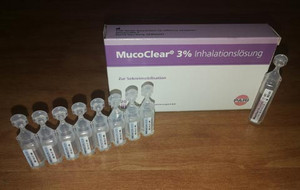Thursday, 17. June 2021

The long-term health consequences of a coronavirus infection may include shortness of breath, a feeling of tightness in the chest, coughing and excess mucus in the airways. Respiratory therapist Marlies Ziegler has observed that these problems can also develop in originally healthy people who hadn’t been diagnosed with a chronic lung condition prior to having COVID-19. During our conversation, she talks about her experiences with treating long COVID lung symptoms and shows how patients can strengthen their lungs, or more accurately, their respiratory system, after getting the coronavirus.
Marlies Ziegler: Last summer, in other words after the first wave, we got two to three inquiries a week from people who had problems with their lungs and breathing after having a coronavirus infection. It was quite noticeable. Then the inquiries died down a bit in the autumn. Now we are getting more again. The inquiries seems to go up a certain amount of time after the waves. We have noticed that people are actively seeking out opportunities to get help dealing their breathing problems after getting a coronavirus infection. For example, many long COVID patients also inquire at the Verein für Reflektorische Atemtherapie [German Society for Reflexive Breathing Therapy] about which practices offer this sort of specialised therapy. Before the coronavirus pandemic, primarily COPD patients contacted the society, now a lot of the inquiries are also from long COVID patients who were originally healthy and did not have chronic lung conditions. At our practice almost all of our inquiries are also from formerly healthy people who now have long COVID symptoms.
Marlies Ziegler: I can only guess why patients with pre-existing pulmonary conditions are less affected by this, or at least we have not seen them at our practice. It might be explained by these patients being more cautious, more consistent in complying with hand washing, distancing and face mask rules, and already being well-versed in good hygiene. Even pre-pandemic, patients with pre-existing pulmonary conditions tended to limit their social contacts during cold and flu season and strictly followed what are now often referred to as the hands/space/face rules. This is something they do regularly to protect themselves as best they can from cold and flu viruses.
Marlies Ziegler: The patients at our practice had coronavirus infections that ranged widely in severity. None of our patients had to be intubated when they had the infection. We have some patients who were treated with supplementary oxygen in hospital, then were sent to under rehabilitation and then were referred to us by their doctor. But we also have patients who were able to manage their infections at home, some only having mild symptoms. They didn’t develop respiratory problems until after they recovered from coronavirus. Not all patients are referred by a doctor. Some come on their own initiative because they want to do something about their respiratory issues.
Marlies Ziegler: One thing patients complain about is that their stamina and exercise capacity is reduced. They get out of breath quickly. One patient, for example, found that since having COVID-19 taking his dog out for daily walks is an activity that wears him out quickly. He needs to take breaks and can’t go the same distances he could before his infection. Patients also often report that their lungs are very sensitive and easily irritated, making them cough a lot. The cough can be dry or it can also be accompanied by difficult-to-clear mucus. Patients often have the feeling they have “sticky” lungs and shortness of breath. When treating them, we notice that it takes a long time until secretions are cleared from the lungs.
Marlies Ziegler: Yes, depending on how severe they are. With some people you can hear that they are short of breath when they talk. We see that it is an effort for some people when they change into different clothes for therapy. For all of the long COVID patients at our practice it appears their diaphragms are out of sync. They are not functioning like they are supposed to. The respiratory movements are not coordinated and instead are disrupted. You can see this, for example, by the fact that the patient’s ribcage does not expand everywhere or completely when taking a breath. On the X-rays patients bring us we often see that some areas of the lung are no longer properly ventilated. In worst case scenarios these symptoms can result in permanent structural lung damage.
Marlies Ziegler: One thing we use a lot is what we call reflexive breathing therapy, which activates the diaphragm to function properly again. We also use resistors and breathing against resistance, to reduce shortness of breath. Inhalation therapy with a nebuliser such as the PARI BOY has been shown to be effective for dry coughs and the feeling of having mucus-filled lungs.

Marlies Ziegler: The 0.9% saline solutions can be used to get coughs more under control. If excessive mucus in the lungs is an issue, then inhalation therapy with a 3% hypertonic saline solution is recommended. In both cases, the patients do the inhalation therapy as needed.
Marlies Ziegler: There is no one clear answer to this. Some patients have to struggle with this for several weeks or months. Some less, some significantly more. And it is worth noting that people who are in good shape and athletic normally recover more quickly from an infection or surgery than those who did not regularly exercise before getting an infection. But for COVID-19 this does not appear to be the case. Even if someone was in good shape before getting the coronavirus, their respiratory system will not necessarily recover more quickly than that of a person who does not exercise. We have also seen this phenomenon at our practice, for example, one of our patients, a formerly healthy, fit man around fifty years old, is today, half a year after his coronavirus infection, not yet at the level of fitness he was at before getting COVID-19. And five months after his infection, a previously spry and active 80-year-old gentleman is not yet back to his pre-COVID condition. He even still needs supplemental oxygen at night. He appears to have developed COPD as a result of his COVID-19 infection.
Marlies Ziegler: Yes, I have some tips, although to be accurate one should talk about training the respiratory system, not just the lungs. I am happy to share the following five tips with long COVID patients, to help them train the respiratory system and help with their recovery:
Marlies Ziegler rlies works as a physiotherapist in a private practice in Munich. She specialises in respiratory physiotherapy. She has been treating patients with chronic obstructive and restrictive airway diseases such as asthma, COPD, cystic fibrosis (CF) and primary ciliary dyskinesia (PCD) for more than 20 years. Since the summer of 2020, increasing numbers of patients with long COVID have also been contacting the specialty practice.
Note: The statements made in the interview are the individual views of the interviewee. They do not necessarily reflect the PARI view or the general state of science.
An article written by the PARI BLOG editorial team.
© 2024 PARI GmbH Spezialisten für effektive Inhalation